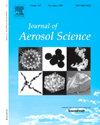Tutorial: A photoacoustic spectrometer to measure aerosol light absorption
IF 3.9
3区 环境科学与生态学
Q2 ENGINEERING, CHEMICAL
引用次数: 0
Abstract
Accurate measurement of aerosol light absorption is essential to reduce uncertainties associated with aerosol radiative forcing in climate models. Contemporary techniques to measure aerosol light absorption continue to suffer from systematic errors and biases that are difficult to quantify. Photoacoustic spectrometry offers a first-principles approach for in-situ measurement of aerosol light absorption. The photoacoustic effect takes place when particles are illuminated by an amplitude-modulated laser, whereupon the particles absorb some amount of incident laser beam energy. Most of the absorbed energy, typically, is released to the surrounding gas as heat, creating pressure waves (sound) of an intensity proportional to that of the modulated laser power. These pressure waves are detected using a sensitive acoustic sensor in real time. This tutorial outlines the working principle of a basic photoacoustic spectrometer (PAS) from a fundamental standpoint, and elucidates its construction by taking into consideration the different design constraints and optical configurations. Methods for data acquisition and signal processing are explained in detail. The tutorial concludes with a brief discussion on PAS calibration techniques, determination of the instrument’s limit of detection, and the intrinsic limitations of the technology.

教程:测量气溶胶光吸收的光声光谱仪
精确测量气溶胶光吸收对于减少气候模式中与气溶胶辐射强迫有关的不确定性至关重要。当代测量气溶胶光吸收的技术仍然存在难以量化的系统性误差和偏差。光声光谱法为气溶胶光吸收的原位测量提供了第一性原理方法。光声效应发生在粒子被调幅激光照射时,粒子吸收入射激光束的能量。通常,吸收的大部分能量以热量的形式释放到周围的气体中,产生与调制激光功率成比例的压力波(声音)。这些压力波是由一个灵敏的声波传感器实时检测到的。本教程从基本的角度概述了基本光声光谱仪(PAS)的工作原理,并通过考虑不同的设计约束和光学配置来阐明其结构。详细说明了数据采集和信号处理的方法。本教程最后简要讨论了PAS校准技术、仪器检测极限的确定以及该技术的内在局限性。
本文章由计算机程序翻译,如有差异,请以英文原文为准。
求助全文
约1分钟内获得全文
求助全文
来源期刊

Journal of Aerosol Science
环境科学-工程:化工
CiteScore
8.80
自引率
8.90%
发文量
127
审稿时长
35 days
期刊介绍:
Founded in 1970, the Journal of Aerosol Science considers itself the prime vehicle for the publication of original work as well as reviews related to fundamental and applied aerosol research, as well as aerosol instrumentation. Its content is directed at scientists working in engineering disciplines, as well as physics, chemistry, and environmental sciences.
The editors welcome submissions of papers describing recent experimental, numerical, and theoretical research related to the following topics:
1. Fundamental Aerosol Science.
2. Applied Aerosol Science.
3. Instrumentation & Measurement Methods.
 求助内容:
求助内容: 应助结果提醒方式:
应助结果提醒方式:


